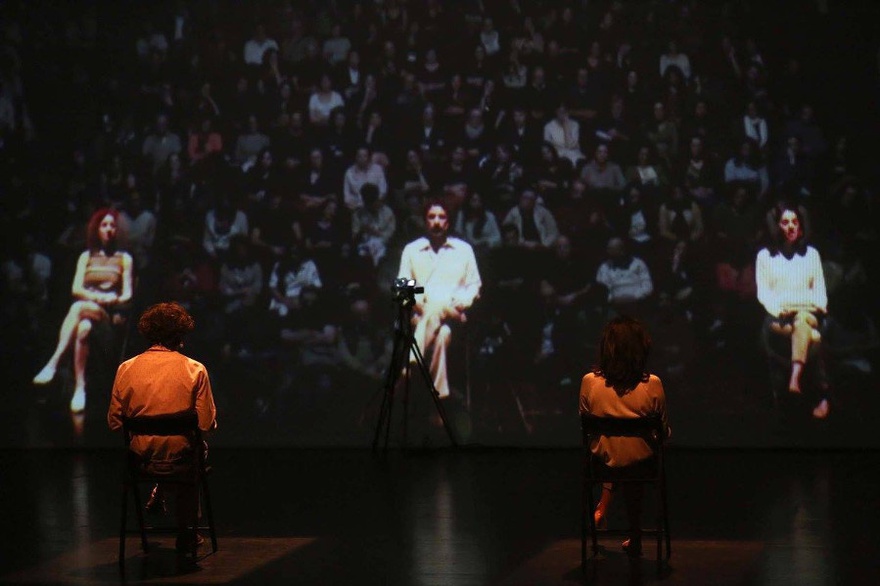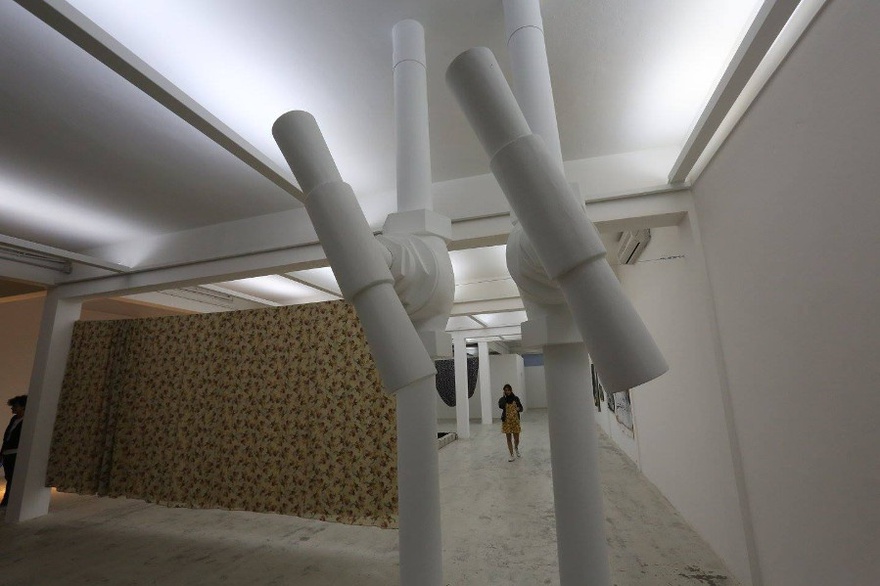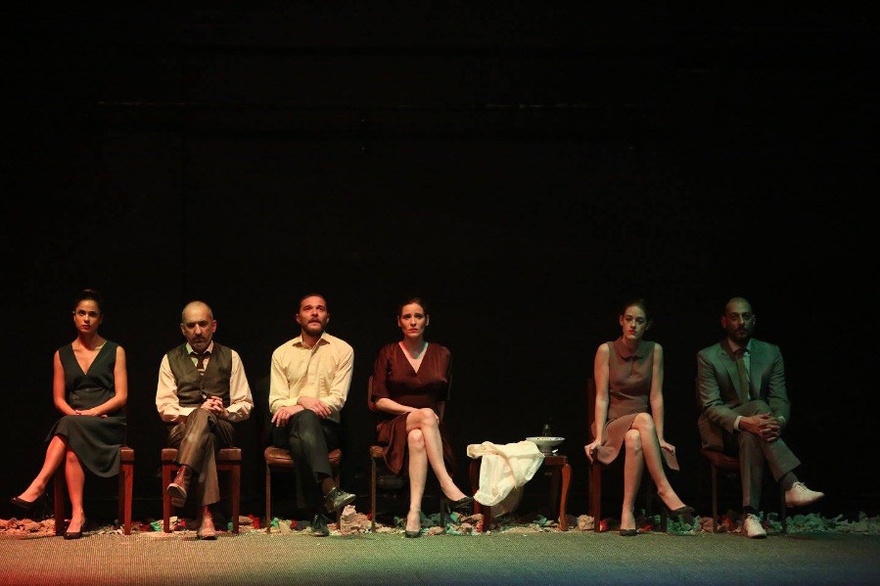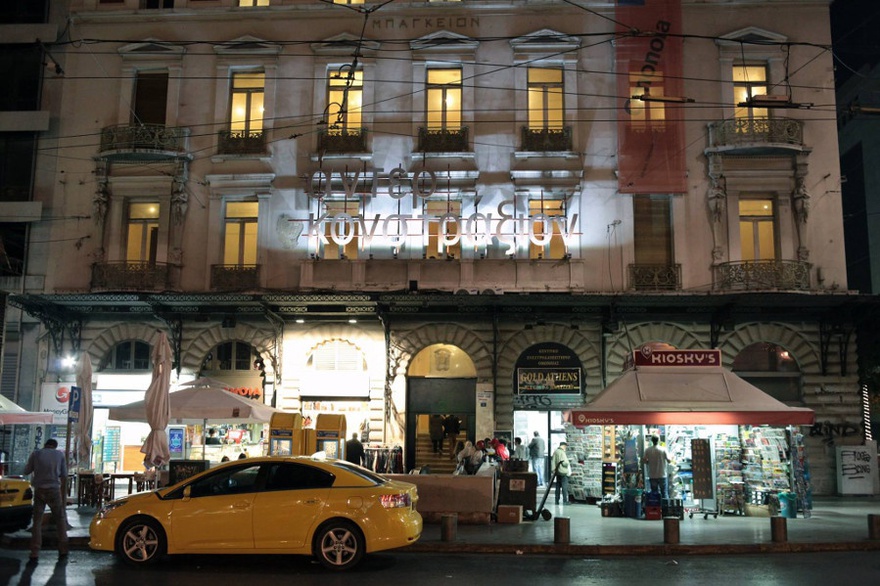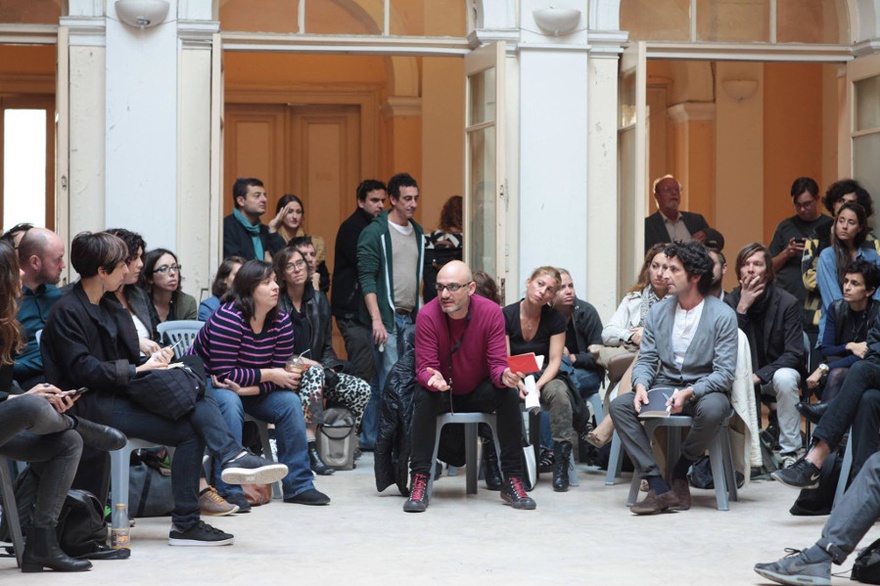News
Real Edgy
A Report from Home Works 7 and Athens Biennale 5 to 6
An interesting discussion took place after a talk delivered at the 7th Home Works Forum on Cultural Practice (or Home Works 7), which ran in Beirut during a tumultuous two weeks in November 2015. (And featured such performances as Ode to Joy, directed by Rabih Mroué and co-written by Manal Khader, both of whom performed with Lina Majdalanie). Ana Texeira Pinto gave an excellently researched paper on the so-called liquidity trap of art – a mapping of the art market as a capitalist behemoth that absorbs originality and regurgitates it as conformity and mediocrity. The issue with the text, for some, was the application of a worn narrative of art becoming increasingly co-opted into the infrastructures of the market. After all, artist Mohammad Salemy noted from the audience: there are other ways for artists to be part of the art world, 'even if they understand the limitations.' Besides, Salemy continued: the problem of market capitalism cannot just be addressed in the art world alone, since this is a political issue related to a historical class struggle that is as global as it is local.
In other words, during times like these, it is not enough to simply hold art accountable to systems and structures that are in fact quite removed from the contexts within which art is being produced and considered. Nor is it enough to address the impact of the market in isolation to the actual spaces within which art is discussed. Take Home Works – an event that, as writer Kaelen Wilson-Goldie pointed out, occurs decisively on the edges, through an institution, Ashkal Alwan, that has evolved since 1993 in and out of a context enmeshed in complex geopolitical conditions. As Wilson-Goldie succinctly summarized, Home Works takes place when a disaster has just passed, is happening, or is about to take place: 'For previous editions, it was the outbreak of the second intifada; the invasion of Iraq; the assassination of Lebanon's former prime minister, Rafik Hariri; the 2006 war with Israel; and fighting in the streets between Hezbollah and rival forces, including Hariri's political movement, Tayyar al-Mustaqbal.'
Thus, in 2015 Home Works 7 opened days before suicide bombings hit a neighbourhood in Beirut, and closed days after Russia ordered Lebanon to shut down its airspace. My first event was Tony Chakar's vast and fragmented lecture, promisingly titled: 'Any World That I'm Welcome to (Is Better Than the World I Come From)'. It began with Eliza Griswold's New York Times article 'Is this the End of Christianity in the Middle East?' accompanied by the explanatory subtitle: 'ISIS and other extremist movements across the region are enslaving, killing and uprooting Christians, with no aid in sight.' Chakar proceeded to consider Christian iconography as a form of written documentation, as well as a cartography not only of formal and material abstractions, but of regional abstractions, too (materials and techniques came from across the Mediterranean and beyond). He then mapped out how such complex abstractions inform his own work.
The end of Chakar's talk marked the beginning of what is characteristic of Home Works presentations: an active discussion session in which questions and comments from the audience point out inconsistencies, or attempt to extract the essence of the talk (in Chakar's case, the relevance to the ISIS article at the start). I could only surmise, as we made our way to the next event, that Chakar's relationship with the language of abstraction suggests that the absence of a point was in fact a point itself. (Such is the state of things today.)
Similarly, there was no theme to Home Works 7. Rather, it was bookended by two exhibitions, which framed the two-week programme of talks, discussions and performances. Christine Tohme curated On Water, Rosemary, and Mercury, shown at the Beirut Art Center, which included a composed group of works, including Ahmed Badry's 2014 series The Provisional Tale That Lasts, in which pipes in the converted industrial space were turned into large valves, and Abbas Akhavan's Variations on a Garden (2015), composed of hanging fabrics. The exhibition was a material counterpoint to Bassam El Baroni's What Hope Looks Like After Hope (On Constructive Alienation) – a digitally inclined curatorial articulation of how relations, both tangible and perceived, are mediated between objects, viewers, and sites. Works included Mohammad Salemy's The Artist Is Hyperpresent (2015), an installation consisting of 'CPUs, screens, and various other computational and photographic accessories' that stream Salemy's 'social media presence into the exhibition space as an object with distinct formal qualities.' A clever side-glance at Marina Abramovic's Museum of Modern Art retrospective in New York titled The Artist is Present, this is a live self-portrait: a sculpture of geometric abstraction activated by an incoming stream of data in real-time. In the context of Beirut, a city where power outages are part of the daily routine, the work was, like this exhibition, a strange anomaly: a reflection of our digital selves in somewhat analogue surroundings.
Nods to Abramovic continued in El Baroni's show in two works from Nelmarie du Preez's Loops of Relation series, to stab (2013) and to rely (2013), in which Du Preez re-enacts two Abramovic performances: the knife game, in which the hand with the knife belongs to a robot, and Rest Energy (1980), where Abramovic leans back from her collaborator Ulay holding an arrow in her hand, aimed at her heart. The works articulated a similar kind of tension that seems to have permeated every aspect of life in 2015, especially in a city like Beirut. Teetering on the edge of the Mediterranean, in a state cornered by Syria, Jordan, Israel, and Turkey, the sense of the present as a tumultuous accelerated mess of history tumbling towards an unknown future feels palpable. To this end, that one of HW7's final panel discussions was titled, 'Art Is As And Against History: A Conversation on Telling Stories in the Present About the Past', was apt. Featuring speakers Elias Khoury and Jayce Salloum, and moderated by Wilson-Goldie, one question came up during the discussion session about what 'the end' might look like today. In response, Khoury described a world quite literally on the edge, over which the forces of geopolitics have real effects, and in which survival has become 'the major moral ethical value'. Khoury then cautioned that what he would say next was sad but true: 'not only intellectuals but maybe all the peoples of this region are becoming outsiders in our countries.' In other words, he continued: 'the destiny of our region […] is in the hands of the regional superpowers.'
Rijin Sahakian was more specific. In a loaded text delivered by curator and researcher Rasha Salti on Sahakian's behalf, the project director of the recently closed non-profit arts organization Sada (which supported young artists in Baghdad) denounced the geopolitical co-option of culture within the Middle East by offering a subjective account of the effects the 2003 American-led invasion of Iraq on local, regional, global, and ultimately historical levels. Sahakian talked about the levelling of libraries, neighbourhoods, and other spaces of culture throughout Iraq and the Middle East, and the remaking of culture once such a process of erasure is complete. 'Museums are being built, catalogues and histories being compiled, auctions, pavilions, and openings setting records of participation and finance,' Sahakian wrote. And this rise in interest in Middle Eastern art cannot be read outside the raging wars that have intensified interest the region, 'and the vast sums being spent by the Gulf as part of a strategic art and culture plan.'
Of course, there were problems with Sahakian's talk for some, as was the case with everything and anything that was included in the Home Works 7 programme. But these problems are simply part of the Home Works experience. (Those who groaned at the thought of watching Naeem Mohaiemen's 2012 film, United Red Army, which reconstructs the events of a hijacking in 1977 by the Japanese Red Army and which has been shown extensively within the region, for example, were left speechless after witnessing the resonance the work has to the present moment.) Within the arguments, new convergences formed. To this end, Salemy, ever the active participant, pointed to a common, albeit abstract thread running through many of the presentations: a deep geopolitical understanding of how regional conflicts in the Middle East are mapped onto the art world. This knowledge relates back to, as Salemy noted in his own talk, 'the psycho-pathetic obsession we have with power and control', which in turn brings us to the idea of a singular 'liquidity trap' and the impasse such narratives tend to lead us.
During one of the many nightly performances, curated by Frie Leysen, Blitz theatre group presented a heart-breaking rendition of Late Night, which tells the story of a world torn apart in abstract and minimal form and structure. The moment the audience is allowed into the theatre, the performance begins, as a group of six sit on a stage set for a party some time in the 1950s. Over an hour and half, the party comes alive as stories that cross different times and spaces unfold within a ballroom-as-world-stage frame. Each individual recalls what occurred as the world collapsed around them through an abstract script composed of snippets that hint towards wider, and familiar, narratives (from the bombed out streets of Berlin, to the events of one November, sometime, somewhere). The tragedy within the performance, both contemporaneous and historical, was summed up in a single line one character asks towards the end: 'What use is memory to liberate ourselves from the past and the future?' It was a question posted to the stunted Left: a project located in a historical struggle that has turned Marx's Capital (1867) into a cruel prophecy, and attempts at 'thinking though' or describing current issues and conditions have led to various states of paralysis.
Amidst such complexity, Salemy posed a crucial question after Sahakian's presentation: How do we 'foster a way of looking at the world not only within the global art world', but 'with a larger intellectual community who really want to understand how things work?' In response, Sahakian talked about the need to connect art and politics with caution when thinking about the different systemic issues we see manifesting globally, though she insisted, 'we cannot look at these things in isolation'. Timely, then, that Home Works 7 took place in tandem with the opening of the 2015 edition of the Athens Biennale that began with a two-day symposium, 'Synapse 1: Introducing a laboratory for production post-2011', held between November 18 and 19, which introduced this Biennale's intentions: to stage a two year process rather than a two-month exhibition (hence this being 'Athens Biennale 5 to 6'). The reason behind the approach, no doubt, is an attempt at actually staging a biennale, despite the economic crisis in Greece that has made this an almost impossible endeavour. The result is an active proposal of thinking beyond the times (and the impasses these times bring) with decisive, and collective, action.
Bringing together a vast list of 'scholars, activists, self-managed organisations, cultural producers and other civic subjects involved in urban practices of commoning, solidarity, urban welfare and participatory democracy' (and a few artists), the experience of the Athens Biennale's opening symposium was akin to sitting in the box the moment after Pandora opened it. Conversations covered the commons, network theory, alternative currencies, and political activism. Participants included such figures as Leo Panitch, co-author of The Making and Unmaking of Global Capitalism (2013), with Sam Gindin, and Athena Athanasiou, co-author of Dispossession: The Performative in the Political (2013), with Judith Butler. Arguments outnumbered the agreements, and a series of working group discussions convened at a final assembly in the main hall of the Bageon Hotel, an abandoned neo-classical building located on the once-grand Omonia Square in Athens, which has become a headquarters for Athens Biennale 5 to 6 for two uneasy months (it is not quite clear how long the Biennale can use the space).
Convened by artistic director and anthropologist Massimilano Mollona, who is working with the Athens Biennale co-founders Poka Yio and Xenia Kalpatsoglou, the aim of this two year process is to steer a radical exhibiton that has essentially opened up the biennial format and its role as an institution to all who wish to take up the challenge (so long as collaboration is realistically possible). The intention is to actively engage with the question of whether or not art can act in highly turbulent and precarious times and whether art can respond with tangible ideas that work in practice. Of course, such noble intentions don't come without their issues: the opening symposium fell prey to the same conflicts many assemblies face when negotiating horizontal action. (Plus there was the uncomfortable fact that the biennale is located in a part of Athens that has been earmarked for regeneration.) But this did not faze the organizers, even if a wide number of participants were left frustrated. (It's worth remembering here that the director is an anthropologist, and that the Biennale's title, Omonoia, means 'concord' in Greek.)
Nevertheless, since its launch, Ab5to6 has charged ahead with its meandering mission, using Bageon as a workshop for a number of local collectives and temporary interventions, from the excellent photography collective Depression Era, to a coalition of students from CalArts brought over for a visit by artist Jenny Marketou. People are coming together to participate in what you might call a durational conference composed with the logic of an occupation. At Bageon, this tone is articulated from the outset in a three-video installation presented on the ground floor by Oliver Ressler and Dario Azzellini's, Occupy, Resist, Produce (2014–2015). These videos follow three factory movements in 2014: Vio.Me in Greece, RiMaflow in Italy, and Officine Zero in France. Through each study, we become observers to each occupied factory's many assemblies – not unlike those that occurred in cities throughout the world in 2011 and 2012, when the Arab uprisings gave way to the Indignados, before Occupy branded the entire thing. But Athens Biennale 5 to 6 is no Berlin Biennale 7; this is not Occupy or any notion of collective and direct democracy put on display in some institutional basement gallery. This is an active space in which the process has become object in toto.
This is why the critique – or at least a detailed description – of how the market impacts cultural production in certain contexts such as Beirut and Athens feels redundant sometimes. It simply reinforces a David and Goliath narrative that smaller, grassroots initiatives working against capitalist norms are being pushed out by global capital when, in fact, despite this reality initiatives are finding ways to navigate – or struggle against – current conditions. (In Beirut, for example, Wilson-Goldie offered the example of the newly opened Aishti Foundation in the city, which is, to Wilson-Goldie, the arrival of 'all that' in a city with a rich historical tradition in the arts.) Nothing is simple, or clearcut. Thus, returning to Salemy and Sahakian's points during Home Works 7, it seems more productive to think about the relations between artistic initiatives such as Home Works and the Athens Biennale, operating as they do in their respective conditions and contradictions, than to think solely about how these two endeavours might become – or are being – absorbed into mono-narrative perpetuated by the dominance of a Godzilla-like market.
At Home Works 7, there was something liberating about sitting in on an active discussion that rejected the narrative of the market in lieu of a more complex and urgent discussion (that inlcuded the market) around the co-opting of art and its discourses in the service of geopolitical agendas. Just as liberating as it was to participate in assemblies organized by the Athens Biennale, in which the object up for debate was the Biennale itself, a move that puts into practice the critique that has long been in circulation: whether the biennale exhibition is a redundant format. The challenges both initiatives face relate to why the liquidity trap – an issue we have all become privy to and complicit in – raised such heated debate after the paper was delivered that evening in Beirut. The question of how one is to transcend – or at least, work with or against – the market in these outright precarious times is being actively thought through in places on the so-called edges, where real work is being done. Better to acknolwedge that fact than to dismiss the effort entirely.

